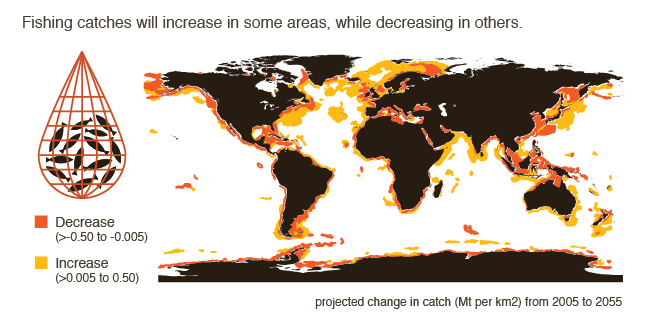Fisheries and Aquaculture

Facts
- The impact of climate change on marine fisheries is expected to differ hugely across the major fishing regions, with catch declining in some regions and growing in others (Cheung et al. 2010).
- Geographic distributions of marine fish species are expected to change, with the ranges of warmer-water species expanding towards the poles and ranges of colder-water species contracting towards the poles (Beare et al. 2004a, 2004b).
- Climate change can directly impact fish physiology, potentially changing the feeding, migration and breeding behaviour of fish; changes in the physical environment (e.g. temperature) can alter the growth, reproductive capacity, mortality and geographic distribution of fish (Brander 2010).
- Progressive acidification of oceans is expected to harm marine shell-forming organisms (e.g. molluscs) and their dependent species (Parry et al. 2007). The vulnerability of coral reefs to ocean warming and acidity is likely to harm the food security concern of countries, such as Solomon Islands, that depend heavily on reef fisheries (Thornton and Cramer 2012).
- Aquaculture behaves more like terrestrial animal husbandry than capture fisheries and therefore shares many of the vulnerabilities and adaptations to climate change with the livestock sector. However, experimental data that can be used to predict aquaculture yields under different climate-change scenarios are still lacking (Easterling et al. 2007).
- Nearly 65% of aquaculture production is onshore and concentrated mostly in the tropical and subtropical regions of Asia. The impact of climate change on aquaculture in such systems is likely to be small and largely positive as a result of enhanced growth rates of cultured stocks (De Silva and Soto 2009)
- The past few decades have seen significant growth in the farming of fish, shellfish, and aquatic plants. Production has grown at 8.3% per year since the mid-1970s. Today, farmed fish constitute around half of all fish consumed by humans (Hu et al., 2013). At present growth rates, aquaculture could represent 5.7% of global N2O emissions by 2030 (Hu et al., 2012).
Sources and further reading
- Beare DJ, Burns F, Greig A, Jones EG, Peach K, Kienzle M, McKenzie E, Reid DG. 2004a. Observations on long-term changes in the prevalence of fish with sourthern biogeographic affinities in the North Sea. Marine Ecology Progress Series 284:269–279. (Available from http://info.ices.dk/products/CMdocs/2003/Q/Q2403.PDF)
- Beare DJ, Burns F, Jones E, Peach K, Portilla E, Greig T, McKenzie E, Reid D. 2004b. An increase in the abundance of anchovies and sardines in the north-western North Sea since 1995. Global Change Biology 10(7):1209–1213. (Available from http://dx.doi.org/10.1111/j.1529-8817.2003.00790.x)
- Brander K. 2010. Impacts of climate change on fisheries. Journal of Marine Systems 79:389–402. (Available from http://dx.doi.org/10.1016/j.jmarsys.2008.12.015)
- Cheung WWL, Lam VWY, Sarmiento JL, Kearney K, Watson R, Zeller D, Pauly D. 2010. Large-scale redistribution of maximum fisheries catch potential in the global ocean under climate change. Global Change Biology 16:24–35. (Available from http://onlinelibrary.wiley.com/doi/10.1111/j.1365-2486.2009.01995.x/pdf)
- Confalonieri U, Menne B, Akhtar R, Ebi KL, Hauengue M, Kovats RS, Revich B, Woodward A. 2007. Human health. In: Parry ML, Canziani OF, Palutikof JP, Van Der Linden PJ, Hanson CE, eds. Climate change 2007: Impacts, adaptation and vulnerability. Contribution of Working Group II to the fourth assessment report of the Intergovernmental Panel on Climate Change. Cambridge, UK: Cambridge University Press. pp. 391–431. (Available from https://www.ipcc.ch/pdf/assessment-report/ar4/wg2/ar4-wg2-chapter8.pdf)
- De Silva SS, Soto D. 2009. Climate change and aquaculture: potential impacts, adaptation and mitigation. In: Cochrane K, De Young C, Soto D, Bahri T, eds. Climate change implications for fisheries and aquaculture: overview of current scientific knowledge. FAO Fisheries and Aquaculture Technical Paper no. 530. Rome: Food and Agriculture Organization of the United Nations. pp. 151–212. (Available from http://www.fao.org/docrep/012/i0994e/i0994e00.htm) (Accessed on 13 November 2013)
- Easterling WE, Aggarwal PK, Batima P, Brander KM, Erda L, Howden SM, Kirilenko A, Morton J, Soussana J-F, Schmidhuber J, Tubiello FN. 2007. Food, fibre and forest products. In: Parry ML, Canziani OF, Palutikof JP, Van Der Linden PJ, Hanson CE, eds. Climate change 2007: Impacts, adaptation and vulnerability. Contribution of Working Group II to the fourth assessment report of the Intergovernmental Panel on Climate Change. Cambridge, UK: Cambridge University Press. (Available from https://www.ipcc.ch/pdf/assessment-report/ar4/wg2/ar4-wg2-chapter5.pdf)
- Hu Z, Lee JW, Chandran K, Kim S , Khanal SK l (2012). Nitrous Oxide (N2O) Emission from Aquaculture: A Review. Environmental Science & Technology 46: 6470–6480
- Hu Z, Lee JW, Chandran K, Kim S, Sharma K, Brotto AC, Khanal SK. 2013. Nitrogen transformations in intensive aquaculture system and its implication to climate change through nitrous oxide emission. Bioresource Technology 130: 314–320.
- Parry ML, Canziani OF, Palutikof JP, Van Der Linden PJ, Hanson CE, eds. 2007. Climate change 2007: Impacts, adaptation and vulnerability. Contribution of Working Group II to the fourth assessment report of the Intergovernmental Panel on Climate Change. Cambridge, UK: Cambridge University Press. 976 pp. (Available from https://www.ipcc.ch/publications_and_data/publications_ipcc_fourth_assessment_report_wg2_report_impacts_adaptation_and_vulnerability.htm)
- Thornton P, Cramer L, eds. 2012. Impacts of climate change on the agricultural and aquatic systems and natural resources within the CGIAR’s mandate. CCAFS Working Paper 23. Copenhagen: CGIAR Research Program on Climate Change, Agriculture and Food Security (Available from http://cgspace.cgiar.org/handle/10568/21226) (Accessed on 13 November 2013)